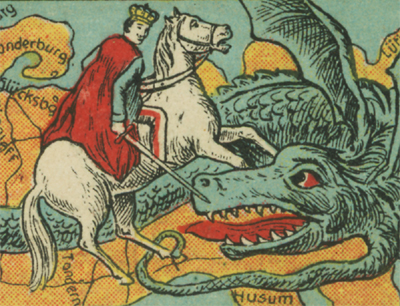 |
Süderbrarup is a small rural German municipality in the district of Schleswig-Flensburg, in the northern most German state of Schleswig-Holstein. It is close to, and just north of, the Schlei, a narrow 20 mile long inlet of the Baltic Sea and is made up largely of larger agricultural estates. Although still small, it has steadily grown through the years. In 1803 it reported a population of 248, 1885 it had risen to 610, by 2005 the population was at 3,893 and today it has a population of roughly 5000 people. The town is the seat of the collective municipality (Amt) of Süderbrarup which includes 13 municipalities in its membership. It is probably best known for the Thorsberg moor archeological site, a peat bog in which the Angles left votive offerings for close to four centuries. Celtic items found here, some with Elder Futhark runic inscriptions, include weapons, shields and clothing such as trousers and tunics. Roman artifacts have also been found here such as a helmet, weapons and two phaleræ, possibly as a result of conflict between tribes such as the Marcomannic war as the Angles had little contact with Romans at this time due to their remoteness.
The Süderbrarup coat of arms was created by Erwin Nobbe in 1940 inspired by a find from the Thorsberg Moor. While there was some difficulty adopting the symbol on the coat of arms because, post war, occupying powers believed it resembled a swastika, it was ultimately adopted when it was explained where the symbol came from and its significance.
There has been a settlement in Süderbrarup possibly dating back to the Stone Age. The existence of numerous burial mounds indicate a dense settlement during the Bronze Age, however towards the end of the Bronze Age, a large part the population diminished significantly with a settlement remaining probably only in the area of Süderbrarup. The settlement by the Germanic tribes who engaged in farming started around 100 AD and it is probable that people from these tribes emigrated to England around 450 AD. The three large burial grounds, all of men, that are found in this area at Sörup (approx. 1375 buried), Husby (1360 buried) and Süderbrarup (approx. 1234 buried) give evidence of the settlement of these people. The number of women's cemeteries is much smaller but are considered much more valuable due to the items were found in them. Unlike other burial sites, the Süderbrarup burial ground has a very long time period of occupation. While the occupancy of the other cemeteries decreased from about 320 AD, it increased in Süderbrarup and lasted until 600 AD or later making the Süderbrarup site one of the last large cemetery sites until the time of the Migration Period.
During the 11th and 12th centuries there was an influx of emigration by the Jute and forested areas were cleared for building and a few estate districts and farms were established. The first mention of Süderbrarup appears in a document from King Valdemar II who mentions the area (as Syndräbrathorp) in a list of his possessions. In 1440 Süderbrarup was again documented, this time in the list of all churches that were under the bishop in Schleswig (this time called Sönderbrarup.)
Between 1626 to 1720 the population dwindled to around 200 inhabitants. In 1777 the chapter monasteries were dissolved and their lands incorporated to other districts. A census held in 1860 showed there were 81 houses, 94 families, and 474 people. Most of the municipalities in the Süderbrarup district were formed in 1871. The estate districts were dissolved in 1928 and assigned to the municipalities. The Flensburg - Kiel railway was opened in 1881 and two years later the Schleswig-Angler Railway opened which had its end point in Süderbrarup.
There is little information during wartime. The municipality suffered like most in Germany during and after the war of shortages and hyperinflation. During the rise of National Socialism it is clear the town was, to some extent, divided as there is an account of disagreements between people, like the postmaster Adolf Petersen who seemed against the Nazi Party, and others in the community who supported the Third Reich. His aversion to National Socialism prompted him to resign a total of eleven honorary posts after the local elections in 1933. After the two world wars, there was significant development of infrastructure and a boom in the population. Still Süderbrarup remains largely a rural and picturesque small farming community. Süderbrarup does host the largest Brarupmarkt, the equivalent of a county fair, in the region consisting of rides, a livestock market, a beauty pageant, lots of drinking and unauthorized after-hours skinny dipping in the municipal pool by local youth. |